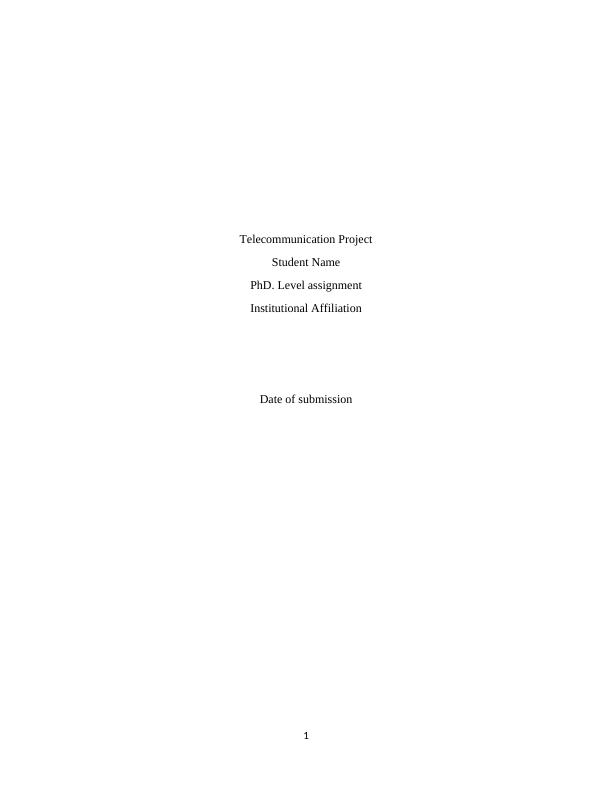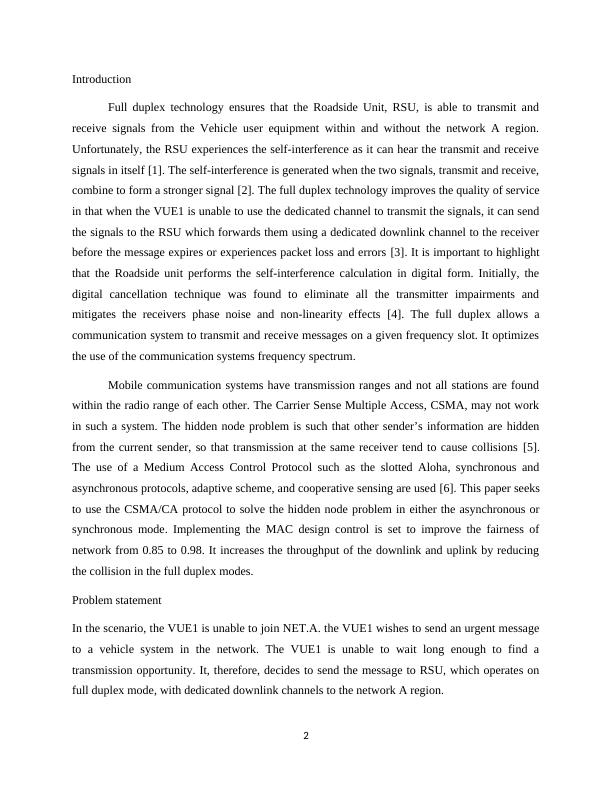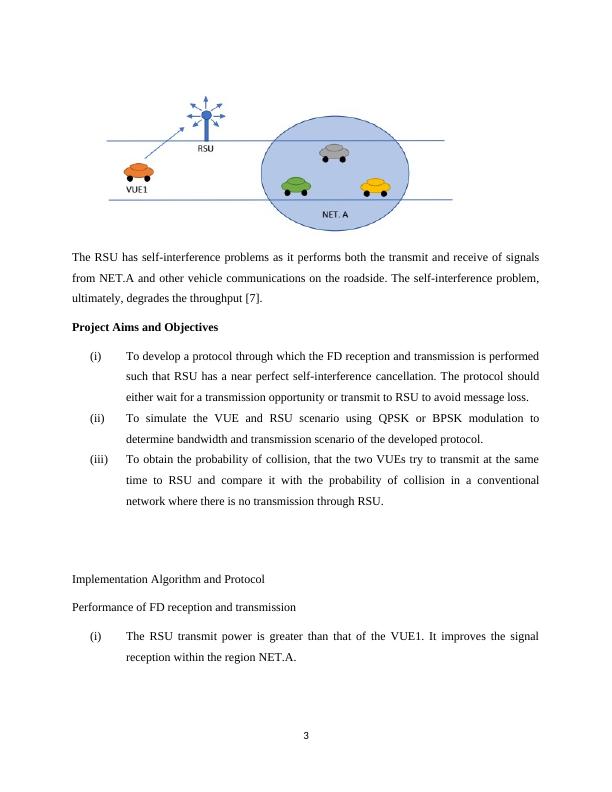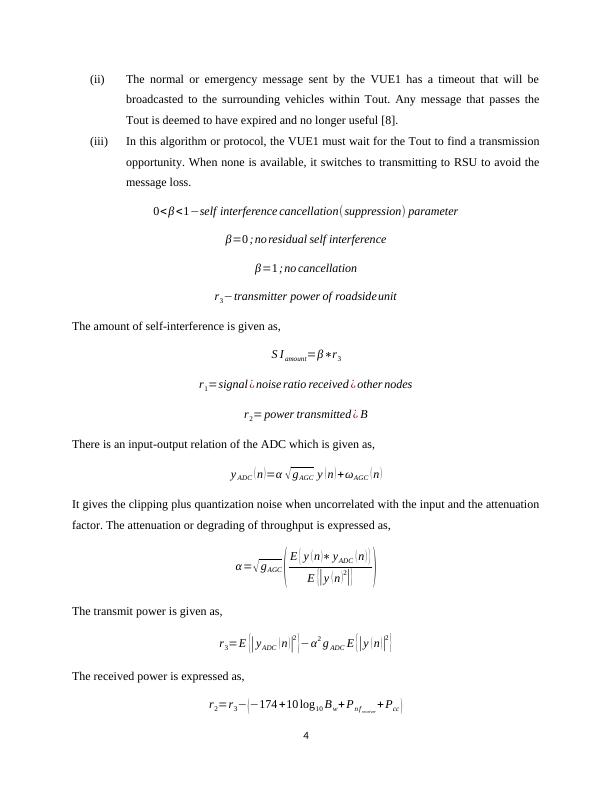Full Duplex Technology for Self-Interference Cancellation in Vehicular Networks
Added on 2023-06-09
11 Pages2660 Words104 Views
Telecommunication Project
Student Name
PhD. Level assignment
Institutional Affiliation
Date of submission
1
Student Name
PhD. Level assignment
Institutional Affiliation
Date of submission
1

Introduction
Full duplex technology ensures that the Roadside Unit, RSU, is able to transmit and
receive signals from the Vehicle user equipment within and without the network A region.
Unfortunately, the RSU experiences the self-interference as it can hear the transmit and receive
signals in itself [1]. The self-interference is generated when the two signals, transmit and receive,
combine to form a stronger signal [2]. The full duplex technology improves the quality of service
in that when the VUE1 is unable to use the dedicated channel to transmit the signals, it can send
the signals to the RSU which forwards them using a dedicated downlink channel to the receiver
before the message expires or experiences packet loss and errors [3]. It is important to highlight
that the Roadside unit performs the self-interference calculation in digital form. Initially, the
digital cancellation technique was found to eliminate all the transmitter impairments and
mitigates the receivers phase noise and non-linearity effects [4]. The full duplex allows a
communication system to transmit and receive messages on a given frequency slot. It optimizes
the use of the communication systems frequency spectrum.
Mobile communication systems have transmission ranges and not all stations are found
within the radio range of each other. The Carrier Sense Multiple Access, CSMA, may not work
in such a system. The hidden node problem is such that other sender’s information are hidden
from the current sender, so that transmission at the same receiver tend to cause collisions [5].
The use of a Medium Access Control Protocol such as the slotted Aloha, synchronous and
asynchronous protocols, adaptive scheme, and cooperative sensing are used [6]. This paper seeks
to use the CSMA/CA protocol to solve the hidden node problem in either the asynchronous or
synchronous mode. Implementing the MAC design control is set to improve the fairness of
network from 0.85 to 0.98. It increases the throughput of the downlink and uplink by reducing
the collision in the full duplex modes.
Problem statement
In the scenario, the VUE1 is unable to join NET.A. the VUE1 wishes to send an urgent message
to a vehicle system in the network. The VUE1 is unable to wait long enough to find a
transmission opportunity. It, therefore, decides to send the message to RSU, which operates on
full duplex mode, with dedicated downlink channels to the network A region.
2
Full duplex technology ensures that the Roadside Unit, RSU, is able to transmit and
receive signals from the Vehicle user equipment within and without the network A region.
Unfortunately, the RSU experiences the self-interference as it can hear the transmit and receive
signals in itself [1]. The self-interference is generated when the two signals, transmit and receive,
combine to form a stronger signal [2]. The full duplex technology improves the quality of service
in that when the VUE1 is unable to use the dedicated channel to transmit the signals, it can send
the signals to the RSU which forwards them using a dedicated downlink channel to the receiver
before the message expires or experiences packet loss and errors [3]. It is important to highlight
that the Roadside unit performs the self-interference calculation in digital form. Initially, the
digital cancellation technique was found to eliminate all the transmitter impairments and
mitigates the receivers phase noise and non-linearity effects [4]. The full duplex allows a
communication system to transmit and receive messages on a given frequency slot. It optimizes
the use of the communication systems frequency spectrum.
Mobile communication systems have transmission ranges and not all stations are found
within the radio range of each other. The Carrier Sense Multiple Access, CSMA, may not work
in such a system. The hidden node problem is such that other sender’s information are hidden
from the current sender, so that transmission at the same receiver tend to cause collisions [5].
The use of a Medium Access Control Protocol such as the slotted Aloha, synchronous and
asynchronous protocols, adaptive scheme, and cooperative sensing are used [6]. This paper seeks
to use the CSMA/CA protocol to solve the hidden node problem in either the asynchronous or
synchronous mode. Implementing the MAC design control is set to improve the fairness of
network from 0.85 to 0.98. It increases the throughput of the downlink and uplink by reducing
the collision in the full duplex modes.
Problem statement
In the scenario, the VUE1 is unable to join NET.A. the VUE1 wishes to send an urgent message
to a vehicle system in the network. The VUE1 is unable to wait long enough to find a
transmission opportunity. It, therefore, decides to send the message to RSU, which operates on
full duplex mode, with dedicated downlink channels to the network A region.
2

The RSU has self-interference problems as it performs both the transmit and receive of signals
from NET.A and other vehicle communications on the roadside. The self-interference problem,
ultimately, degrades the throughput [7].
Project Aims and Objectives
(i) To develop a protocol through which the FD reception and transmission is performed
such that RSU has a near perfect self-interference cancellation. The protocol should
either wait for a transmission opportunity or transmit to RSU to avoid message loss.
(ii) To simulate the VUE and RSU scenario using QPSK or BPSK modulation to
determine bandwidth and transmission scenario of the developed protocol.
(iii) To obtain the probability of collision, that the two VUEs try to transmit at the same
time to RSU and compare it with the probability of collision in a conventional
network where there is no transmission through RSU.
Implementation Algorithm and Protocol
Performance of FD reception and transmission
(i) The RSU transmit power is greater than that of the VUE1. It improves the signal
reception within the region NET.A.
3
from NET.A and other vehicle communications on the roadside. The self-interference problem,
ultimately, degrades the throughput [7].
Project Aims and Objectives
(i) To develop a protocol through which the FD reception and transmission is performed
such that RSU has a near perfect self-interference cancellation. The protocol should
either wait for a transmission opportunity or transmit to RSU to avoid message loss.
(ii) To simulate the VUE and RSU scenario using QPSK or BPSK modulation to
determine bandwidth and transmission scenario of the developed protocol.
(iii) To obtain the probability of collision, that the two VUEs try to transmit at the same
time to RSU and compare it with the probability of collision in a conventional
network where there is no transmission through RSU.
Implementation Algorithm and Protocol
Performance of FD reception and transmission
(i) The RSU transmit power is greater than that of the VUE1. It improves the signal
reception within the region NET.A.
3

(ii) The normal or emergency message sent by the VUE1 has a timeout that will be
broadcasted to the surrounding vehicles within Tout. Any message that passes the
Tout is deemed to have expired and no longer useful [8].
(iii) In this algorithm or protocol, the VUE1 must wait for the Tout to find a transmission
opportunity. When none is available, it switches to transmitting to RSU to avoid the
message loss.
0< β <1−self interference cancellation(suppression) parameter
β=0 ; no residual self interference
β=1 ; no cancellation
r3−transmitter power of roadsideunit
The amount of self-interference is given as,
S I amount=β∗r3
r1=signal ¿ noise ratio received ¿ other nodes
r2= power transmitted ¿ B
There is an input-output relation of the ADC which is given as,
y ADC ( n ) =α √ gAGC y ( n ) +ωAGC ( n )
It gives the clipping plus quantization noise when uncorrelated with the input and the attenuation
factor. The attenuation or degrading of throughput is expressed as,
α = √ gAGC ( E { y ( n )∗ yADC ( n ) }
E {| y ( n ) 2
|} )
The transmit power is given as,
r3=E {| yADC ( n )|
2
}−α2 g ADC E {| y ( n )|
2
}
The received power is expressed as,
r2=r3− (−174 +10 log10 Bw+ Pn f receiver
+ Pcc )
4
broadcasted to the surrounding vehicles within Tout. Any message that passes the
Tout is deemed to have expired and no longer useful [8].
(iii) In this algorithm or protocol, the VUE1 must wait for the Tout to find a transmission
opportunity. When none is available, it switches to transmitting to RSU to avoid the
message loss.
0< β <1−self interference cancellation(suppression) parameter
β=0 ; no residual self interference
β=1 ; no cancellation
r3−transmitter power of roadsideunit
The amount of self-interference is given as,
S I amount=β∗r3
r1=signal ¿ noise ratio received ¿ other nodes
r2= power transmitted ¿ B
There is an input-output relation of the ADC which is given as,
y ADC ( n ) =α √ gAGC y ( n ) +ωAGC ( n )
It gives the clipping plus quantization noise when uncorrelated with the input and the attenuation
factor. The attenuation or degrading of throughput is expressed as,
α = √ gAGC ( E { y ( n )∗ yADC ( n ) }
E {| y ( n ) 2
|} )
The transmit power is given as,
r3=E {| yADC ( n )|
2
}−α2 g ADC E {| y ( n )|
2
}
The received power is expressed as,
r2=r3− (−174 +10 log10 Bw+ Pn f receiver
+ Pcc )
4

End of preview
Want to access all the pages? Upload your documents or become a member.
Related Documents
Challenges and Solutions in Full Duplex Communicationlg...
|9
|1873
|479